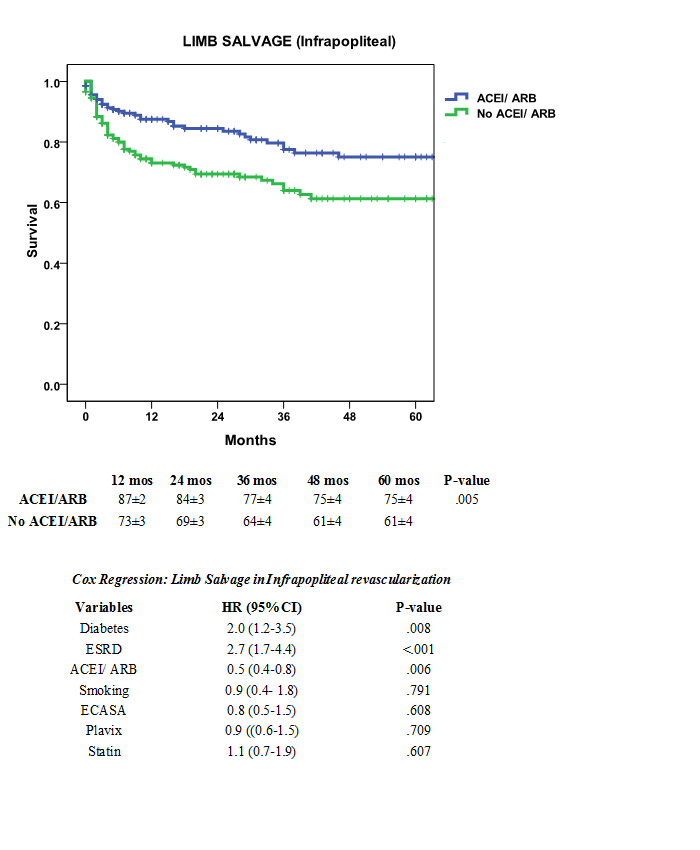Angiotensin Converting Enzyme Inhibitors and Angiotensin II Receptor Blockers (ACEI/ARB) are Associated with Improved Limb Salvage After Infrapopliteal Interventions for Critical Limb Ischemia
Sikandar Z. Khan, MD1, Mariel Rivero, MD2, Linda M. Harris, MD1, Maciej L. Dryjski, MD1, Hasan H. Dosluoglu, MD2.
1State University of New York at Buffalo, Buffalo, NY, USA, 2VA Western NY Healthcare System, State University of New York at Buffalo, Buffalo, NY, USA.
Angiotensin Converting Enzyme Inhibitors and Angiotensin II Receptor Blockers (ACEI/ARB) are Associated with Improved Limb Salvage After Infrapopliteal Interventions for Critical Limb Ischemia
Objective:
Angiotensin Converting Enzyme Inhibitors and Angiotensin II Receptor Blockers (ACEI/ARB) reduce the risk of cardiovascular events in patients with peripheral arterial disease (PAD). However, their effect on limb specific outcomes after revascularization is unknown. The objective of this study was to assess the effect of ACEI/ARB on patency and limb salvage in patients undergoing intervention for critical limb ischemia (CLI).
Methods
Patients who underwent revascularization for CLI (Rutherford 4-6) between 06/2001-12/2014 were retrospectively identified. Primary Patency(PP), Secondary Patency(SP), Limb Salvage(LS) and survival rates of patients on ACEI/ARB were compared to those not on ACEI/ARB using Kaplan-Meier and Cox regression.
Results
860 limbs in 710 patients were identified( 353 ACEI/ARB, 357 No ACEI/ARB). Hypertension (87% vs 70% ), diabetes (65% vs 50%) and statin use (61% vs 46%) were significantly greater in the ACEI/ARB group(P < .05). Interventions were performed for mostly tissue loss (78% ACEI/ARB vs 79% No ACEI/ARB, P= .658). Comparing ACEI/ARB vs No ACEI/ARB, in aortoiliac interventions, 60-month PP (79% vs 71%), SP (90% vs 85%) and LS (97% vs 91%) were not significantly different (P >.05). In femoropopliteal interventions, 60-month PP (54% vs 55%), SP (76% vs 75%) and LS (84% vs 87%) were not significantly different (P >.05). In infrapopliteal interventions, 60-month PP (45% vs 46%) and SP (62% vs 75%) were not significantly different(P >.05). LS was significantly greater in ACEI/ARB (75%) vs No ACEI/ARB (61%) (P= .005). LS was significantly greater in ACEI/ARB after both endovascular and open interventions. Cox regression identified diabetes (HR 2.0(1.2-3.5) P=.008), ESRD (HR 2.7(1.7-4.4) P<.001) and ACEI/ARB (HR 0.5(0.4-0.8) P=.006) as LS predictors after infrapopliteal interventions. Overall survival was not significantly different(60-month, 43% vs 37%, P=.843).
Conclusion
ACEI/ARB use is associated with improved limb salvage but not better patency rates in CLI patients undergoing endovascular or open infrapopliteal interventions, but not after aortoiliac or femoropopliteal interventions. Our findings supplement the growing body of evidence supporting the use of ACEI/ARB in patients with PAD. 
Back to 2017 Program




